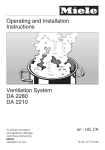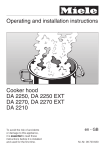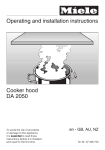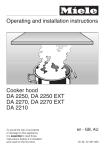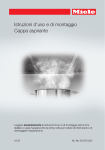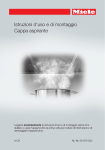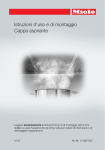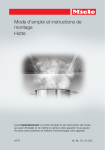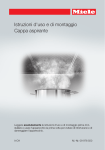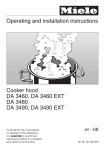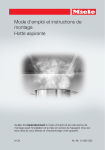Download Miele DA 2210 Technical data
Transcript
Installation Instructions DA 2210 DA 2280 en-CA Installation, repair and maintenance work should be performed by a Miele authorized service technician in accordance with national and local safety regulations and the provided installation instructions. IMPORTANT SAFETY INSTRUCTIONS READ AND SAVE THESE INSTRUCTIONS Keep these instructions in a safe place and pass them on to any future user. Read these instructions carefully before installing or using the Ventilation System. ~ This appliance is intended for residential use only. Use the appliance only for its intended purpose. ~ This appliance complies with current safety requirements. Improper use of the appliance can lead to personal injury and material damage. ,CAUTION For General Ventilating Use Only. Do Not Use To Exhaust Hazardous Or Explosive Materials And Vapors. ~ This appliance is designed to vent cooking smoke and odors only. ~ This appliance is suitable for installation above gas or electric cooking surfaces. ,WARNING TO REDUCE THE RISK OF FIRE, ELECTRIC SHOCK, OR INJURY TO PERSONS, OBSERVE THE FOLLOWING: ~ a) Use this appliance only in the manner intended by the manufacturer. If you have questions, contact Miele. ~ b) Before servicing or cleaning the appliance, switch power off at the service panel and lock the service disconnecting means to prevent power from being switched on accidentally. If the service disconnecting means cannot be locked, securely fasten a prominent warning device, such as a tag, to the service panel. ~ c) Be certain your appliance is properly installed and grounded by a qualified technician. To guarantee the electrical safety of this appliance, continuity must exist between the appliance and an effective grounding system. It is imperative that this basic safety requirement be met. If there is any doubt, have the electrical system of the house checked by a qualified electrician. ~ This appliance is not designed for maritime use or for use in mobile installations such as recreational vehicles or aircraft. However, under certain conditions installation in these applications may be possible. Please contact your Miele dealer or the Miele Technical Service Department with specific requirements. 3 IMPORTANT SAFETY INSTRUCTIONS ~ d) Before connecting the appliance to the power supply make sure that the voltage and frequency listed on the data plate correspond with the household electrical supply. This data must correspond to prevent appliance damage. If in doubt consult a qualified electrician. ~ e) Installation work and repairs should only be performed by a qualified technician in accordance with all applicable codes and standards. Repairs and other work by unqualified persons could be dangerous. ~ f) Only open the housing as described in the enclosed "Installation diagram" and in the "Cleaning and care" section of this manual. Under no circumstances should any other parts of the housing be opened. Tampering with electrical connections or components and mechanical parts is highly dangerous to the user and can cause operation faults. ~ g) Before discarding an old appliance, disconnect it from the power supply and remove the power cord to prevent hazards. 4 Use ,WARNING TO REDUCE THE RISK OF A COOKTOP GREASE FIRE: ~ a) Never leave surface units unattended at high settings. Boilovers cause smoking and greasy spillovers may ignite. Heat oils slowly on low or medium settings. ~ b) Always turn the hood on when cooking at a high heat. ~ c) Clean the ventilation hood frequently. Grease should not be allowed to accumulate on the fan or filter. ~ d) Use the proper pan size. Always use cookware appropriate for the size of the cooking area. ~ e) Do not flambé or grill with an open flame beneath the hood. Flames could be drawn up into the hood by the suction and the grease filters may catch fire. IMPORTANT SAFETY INSTRUCTIONS ,WARNING TO REDUCE THE RISK OF INJURY TO PERSONS IN THE EVENT OF A COOKTOP GREASE FIRE, OBSERVE THE FOLLOWING*: ~ Do not allow children to play with or ~ a) SMOTHER FLAMES with a close fitting lid, cookie sheet, or metal tray then turn off the burner. BE CAREFUL TO PREVENT BURNS. If the flames do not go out immediately, EVACUATE AND CALL THE FIRE DEPARTMENT. ~ Never operate gas burners without ~ b) NEVER PICK UP A FLAMING PAN - You may be burned. operate the appliance or its controls. Supervise its use by the elderly or infirm. ~ Always turn on the hood when using the cooktop to prevent damage from condensation. cookware. Turn the burner off when not in use. Adjust the burner so that the flames do not extend beneath the cookware. Do not overheat the cookware, e.g. when using a wok. The hood can be damaged due to excessive heat from the burners and the cookware. ~ c) DO NOT USE WATER, including wet dishcloths or towels - a violent steam explosion will result. ~ Do not use the hood without the ~ d) Use a fire extinguisher ONLY if: the hood. Steam could penetrate electrical components and cause a short circuit. 1) You have a class ABC extinguisher, and you know how to operate it. grease filters in place. ~ Do not use a steam cleaner to clean 2) The fire is small and contained in the area where it started. 3) The fire department is being called. 4)You can fight the fire with your back to an exit. * Based on "Kitchen Firesafety Tips" published by NAFTA 5 IMPORTANT SAFETY INSTRUCTIONS Installation ~ g) Do not install this hood over cooktops that burn solid fuel. ,WARNING TO REDUCE THE RISK OF FIRE, ELECTRIC SHOCK, OR INJURY TO PERSONS, OBSERVE THE FOLLOWING: ~ a) Installation work and electrical wiring must be done by qualified person(s) in accordance with all applicable codes and standards, including fire-rated construction. ~ b) Sufficient air is needed for combustion and exhausting of gases through the flue (chimney of fuel burning equipment to prevent back drafting. Follow the heating equipment manufacturer’s guideline and safety standards such as those published by the National Fire Protection Association (NFPA) and the American Society for Heating, Refrigeration and Air Conditioning Engineers (ASHRAE), and the local code authorities. ~ c) When cutting or drilling into the wall or ceiling, do not damage electrical wiring and other hidden utilities. ~ d) Ducted hoods must always be vented to the outdoors. ~ e) Do not use this hood with any solid-state speed control device. ~ f) Do not use an extension cord to connect the appliance to electricity. Extension cords do not guarantee the required safety of the appliance, (e.g. danger of overheating). 6 ~ h) Provided a larger distance is not given by the manufacturer of the cooktop, follow the minimum safety distances between a cooktop and the bottom of the hood given in the "Appliance dimensions" section of this manual. If local building codes require a greater safety distance, follow their requirement. If there is more than one appliance beneath the hood and they have different minimum safety distances always select the greater distance. ~ i) Never connect an exhaust hood to an active chimney, dryer vent, vent flue, or room ventilating ductwork. ~ j) Seek professional advice before connecting an exhaust hood vent to an existing, inactive chimney or vent flue. ~ k) Any fittings, sealant, or materials used to install the ductwork must be made of approved non-flammable materials. ,WARNING TO REDUCE THE RISK OF FIRE USE ONLY METAL DUCTWORK. Appliance dimensions DA 2280 25 Appliance dimensions DA 2210 26 Appliance dimensions *Cut out dimensions A depth T, min. 1" (25 mm), is necessary in the rear of the cabinet. Distance between cooktop and hood (S) Do not install this exhaust hood over cooktops burning solid fuel. Provided a larger distance is not given by the manufacturer of the cooktop, follow the minimum safety distances between a cooktop and the bottom of the hood: Miele Cooktops Non-Miele Cooktops Electric Cooktops 24" (610 mm) Electric Barbeques and Fryers 26" (660 mm) Multiburner Gas cooktops < 43,000 BTU (12.6 KW) and no burner > 15,000 BTU (4.5 KW) 26" (660 mm) 30" (760 mm) Single burner (Wok) < 20,500 BTU (6 KW) 26" (660 mm) 30" (760 mm) All other gas cooktops 30" (760 mm) – If several gas surfaces are installed under the hood, the total output must be considered when determining the minimum safety distance. – If installing the exhaust hood in an overhead cabinet, observe the instructions of the manufacturer of the gas cooktop regarding the use of very flammable materials above the cooktop. If not otherwise specified in the instructions, ensure a distance of at least 30” (762 mm) from the gas cooktop. – If local building codes require a greater safety distance, follow their requirement. – If there is more than one appliance beneath the hood and they have different minimum safety distances always select the greater distance. See "Important Safety Instructions" for further information. 27 Installation ^ Please read the "Important Safety Instructions" and Installation instructions before installing this hood. Non-return flap Installation The hood is designed to be installed within cabinetry and kitchen islands. The top half (motor and fan assembly) should be accessible after installation. If the motor and fan assembly are not accessible, assemble the ductwork and the electrical connection before the installation. The hood comes equipped with a non-return flap. This flap automatically closes when the hood is turned off so that no exchange of outside air and room air can occur. Uninstall the non-return flap when your exhaust system is equipped with a non-return flap or if the hood is used in recirculation mode. ^ Holding the non-return flap at the wire, pull it out of the bracket. The DA 2280 is equipped with one, the DA 2210 with two non-return flaps. ,CAUTION To avoid risk of hand or other injury, avoid contact with sharp edges during the assembly and installation process. 28 ^ Insert and align the hood from the bottom up in the cut out. ^ Secure the hood through the frame with the screws (3.5 x 16 mm). Installation Preparation for air extraction mode ^ See "Air extraction" for further information on installing the exhaust hose. ^ DA 2210: The hood has two vent collars for two 6" (150 mm) diameter exhaust hoses. The supplied Yadapter can be used to feed the exhaust from both connections into an 8" (200 mm) diameter common duct. dai2699 ^ If using a 6" (150 mm) diameter exhaust hose, attach the supplied vent collar to the exhaust hose with a hose clamp. ^ If using a 5" (125 mm) diameter exhaust hose, place the supplied reducing collar into the vent collar and attach the exhaust hose to the reducing collar with a hose clamp. (see "Air extraction"). dai2717 ^ Place the exhaust hose onto the vent collar of the hood. 29 Installation 14 3 dai2453 Recirculation mode DA 2280 installation needs one installation kit and two active charcoal filters 31 9 DA 2210 installation needs two installation kits and four active charcoal filters 10 A non-return flap is not needed in recirculation mode. 24 ^ Install the installation kit according to the installation situation. 90 11 0 0 22 3 40 33 160 0 15 If site conditions are not suitable for the hood to be used for air extraction, the appliance must be converted for recirculation using the following installation kit. It can be ordered from your Miele dealer or the Technical Service Dept. It contains a 6" (150 mm) diameter hose, a grille and a hose clamp to secure the hose at the exhaust connection of the hood. 30 When installing the recirculation vents make sure that the slats point towards the center of the room and not to a wall or the ceiling. ^ Install the active charcoal filters (see "Cleaning and Care") and reprogram the charcoal filter timer. Installation Installing the joystick Joystick extension The joystick can be extended for an easier reach. ^ Screw the spring into the socket and tighten by hand. At the same time hold the socket using a SW 9 wrench, do not rotate. ^ Screw the base onto the spring and tighten by hand. Again, hold the socket with the wrench, do not rotate. ^ Place the bottom section of the joystick onto the base and loosely secure it in place with the included screw and spring washer. Turn the printing on the bottom section so that the m-symbol faces the front. ^ Place a spring washer between the joystick base and the extension. Tighten the extension by hand while holding the joystick base with a wrench. ^ Attach the lower part of the joystick to the extension with a spring washer. Turn the m-symbol to the front and screw in place with an allen wrench while using a wrench to hold the joystick base. ^ Tighten the screw with a 3 mm Allen wrench. At the same time hold the socket with the wrench, do not rotate. 31 Installation Electrical connection Before connecting the appliance to power read the "Important Safety Instructions". ^ Plug in the power cord. Before using the appliance remove the grease filters and remove the protective foil from the filter frame. Insert the grease filters back into place. 32 Air extraction ,WARNING Danger of toxic fumes. Gas cooking appliances release carbon monoxide that can be harmful or fatal if inhaled. To reduce the risk of fire and to properly exhaust air, the exhaust gases extracted by the hood should be vented outside of the building only. Do not vent exhaust air into spaces within walls or ceilings or in attics, crawl spaces or garages. To reduce the risk of fire, only use metal ductwork. Please read and follow the "IMPORTANT SAFETY INSTRUCTIONS" to reduce the risk of personal injury. Follow all local building codes when installing the hood. Exhaust ducting and connections Use smooth or flexible pipework made from approved non-flammable materials for exhaust ducting. To achieve the most efficient air extraction and quietest noise levels, consider the following: – The diameter of the ductwork should not be less than 6" (150 mm). – If flat ducting is used, the cross section must not be smaller than the cross section of the ventilation exhaust. – The ducting should be as short and straight as possible. – Use ductwork with a wide radius. – The exhaust duct must not be bent or compressed. – Make sure all connections are secure. – Where the ductwork is horizontal, it must slope away from the hood at least 1/8" per foot (1 cm per meter) to prevent condensation dripping into the appliance. – If the exhaust is ducted through an outside wall, a Telescopic Wall Vent can be used. 33 Air extraction Condensate trap optional accessory – If the exhaust is ducted into an inactive flue, the air must be expelled parallel to the flow direction of the flue. Never connect an exhaust hood to an active chimney, dryer vent, flue, or room venting ductwork. Seek professional advice before connecting an exhaust hood vent to an existing, inactive chimney or vent flue. Important If the ductwork runs through rooms, ceilings, garages, etc. where temperature variations exist, it may need to be insulated to reduce condensation. 34 In some cases, a condensate trap may also be required to collect and evaporate any condensate which may occur. This optional accessory is available for ducts 5" (125 mm) and 6" (150 mm) in diameter. ^ When installing a condensate trap, ensure that it is positioned vertically and if possible directly above the exhaust outlet. Electrical connection ,WARNING TO REDUCE THE RISK OF FIRE, ELECTRIC SHOCK, OR INJURY TO PERSONS, OBSERVE THE FOLLOWING: All electrical work should be performed by a qualified electrician in strict accordance with national regulations (for USA: ANSI-NFPA 70) and local safety regulations. Installation, repairs and other work by unqualified persons could be dangerous. Ensure that power to the appliance is off while installation or repair work is performed. ^ Verify that the voltage, load and circuit rating information found on the data plate (located behind the grease filters), match the household electrical supply before installing the hood. ,WARNING! In Canada, the ventilation hood should be plugged into a outlet which is not enclosed in a cupboard, cabinet or similar enclosure per the Canadian Electrical Code. Grounding Instructions This appliance must be grounded. In the event of an electrical short circuit, grounding reduces the risk of electric shock by providing a path of least resistance. This appliance is equipped with a cord having a grounding wire with a grounding plug. The plug must be plugged into an outlet that is properly installed and grounded. WARNING - Improper grounding can result in a risk of electric shock. If there is any doubt, have the electrical system of the house checked by a qualified electrician. Do not use an extension cord. If the power supply cord is too short, have a qualified electrician install an outlet near the appliance. Important The hood comes equipped with a 4 ft (1.2 m) power cord with a NEMA 5-15 molded plug for connection to a 120 VAC, 60 Hz, 15 A power outlet. If there is any question concerning the electrical connection of this appliance to your power supply, please consult a licensed electrician or call Miele’s Technical Service Department. See back cover for contact information. ,WARNING: THIS APPLIANCE MUST BE GROUNDED 35 Technical data DA 2280 Maximum load . . . . . . . . . . . . . . . 450 W Fan. . . . . . . . . . . . . . . . . . . . . . . 350 W Light. . . . . . . . . . . . . . . . . . . . 2 x 50 W DA 2210 Maximum load . . . . . . . . . . . . . . . 900 W Fan . . . . . . . . . . . . . . . . . . . 2 X 350 W Light. . . . . . . . . . . . . . . . . . . . 4 x 50 W Voltage . . . . . . . . . . . . . . . . . . . . . 120 V Frequency . . . . . . . . . . . . . . . . . . 60 Hz Circuit rating. . . . . . . . . . . . . . . . . . 15 A Weight DA 2280 . . . . . . . . . . . 23.1 lb (10.5 kg) DA 2210 . . . . . . . . . . . 35.3 lb (23.1 kg) 36 Alteration rights reserved / 0910 M.-Nr. 07 773 240 / 01 INFORMATION IS SUBJECT TO CHANGE. PLEASE REFER TO OUR WEBSITE TO OBTAIN THE MOST CURRENT PRODUCT SPECIFICATIONS, TECHNICAL & WARRANTY INFORMATION.


















